You have an Azure subscription that contains 10 virtual machines on a virtual network.
You need to create a graph visualization to display the traffic flow between the virtual machines.
What should you do from Azure Monitor?
- A. From Activity log, use quick insights.
- B. From Metrics, create a chart.
- C. From Logs, create a new query.
- D. From Workbooks, create a workbook.
Answer : C
Explanation:
Navigate to Azure Monitor and select Logs to begin querying the data
Reference:
https://azure.microsoft.com/en-us/blog/analysis-of-network-connection-data-with-azure-monitor-for-virtual-machines/
HOTSPOT -
You plan to create an Azure Storage account in the Azure region of East US 2.
You need to create a storage account that meets the following requirements:
✑ Replicates synchronously
✑ Remains available if a single data center in the region fails
How should you configure the storage account? To answer, select the appropriate options in the answer area.
NOTE: Each correct selection is worth one point.
Hot Area:
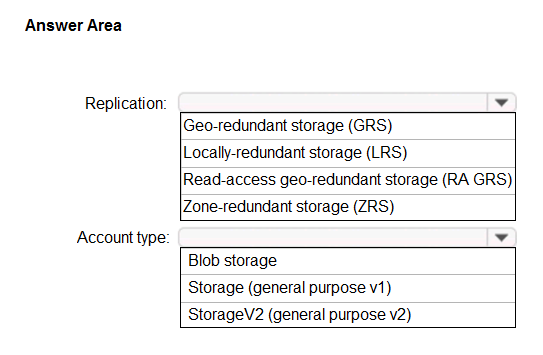
Answer :
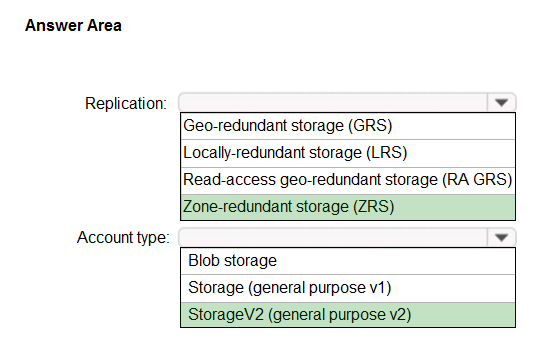
Explanation:
Box 1: Zone-redundant storage (ZRS)
Zone-redundant storage (ZRS) replicates your data synchronously across three storage clusters in a single region.
LRS would not remain available if a data center in the region fails
GRS and RA GRS use asynchronous replication.
Box 2: StorageV2 (general purpose V2)
ZRS only support GPv2.
Reference:
https://docs.microsoft.com/en-us/azure/storage/common/storage-redundancy https://docs.microsoft.com/en-us/azure/storage/common/storage-redundancy-zrs
HOTSPOT -
You plan to deploy an Azure virtual machine named VM1 by using an Azure Resource Manager template.
You need to complete the template.
What should you include in the template? To answer, select the appropriate options in the answer area.
NOTE: Each correct selection is worth one point.
Hot Area:
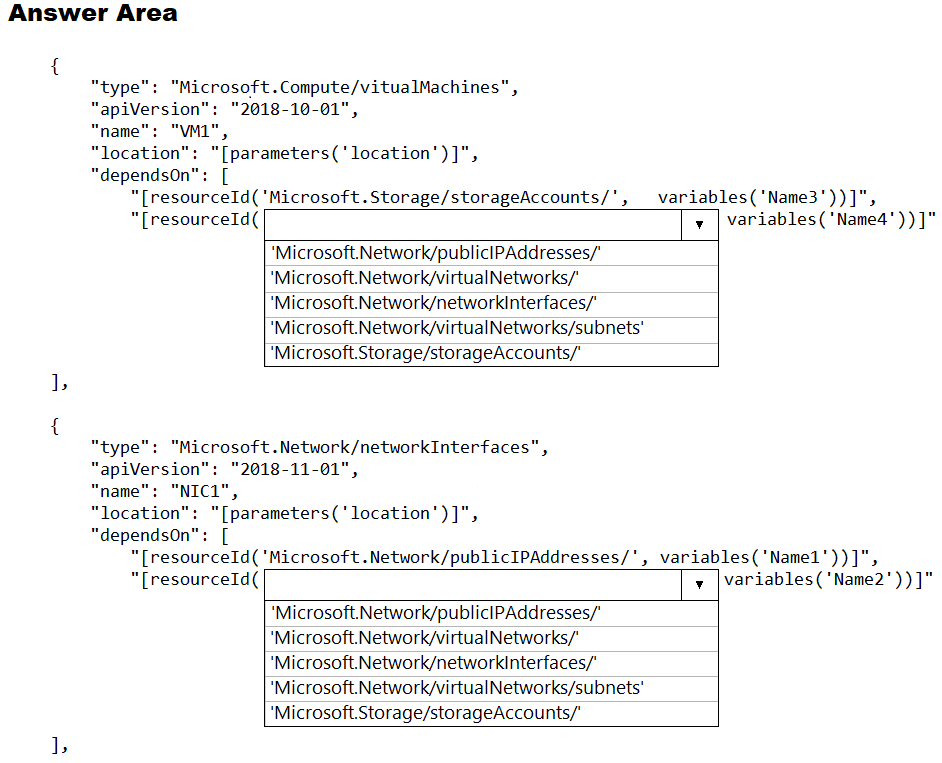
Answer :
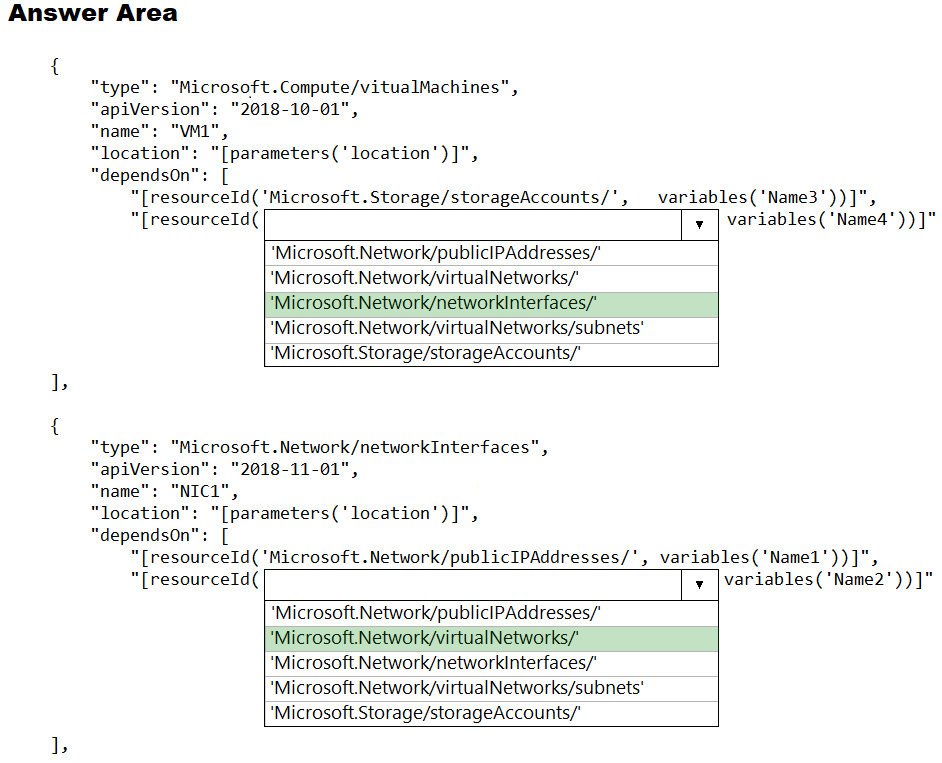
Explanation:
Within your template, the dependsOn element enables you to define one resource as a dependent on one or more resources. Its value can be a comma- separated list of resource names.
Box 1: 'Microsoft.Network/networkInterfaces'
This resource is a virtual machine. It depends on two other resources:
Microsoft.Storage/storageAccounts
Microsoft.Network/networkInterfaces
Box 2: 'Microsoft.Network/virtualNetworks/'
The dependsOn element enables you to define one resource as a dependent on one or more resources. The resource depends on two other resources:
Microsoft.Network/publicIPAddresses
Microsoft.Network/virtualNetworks
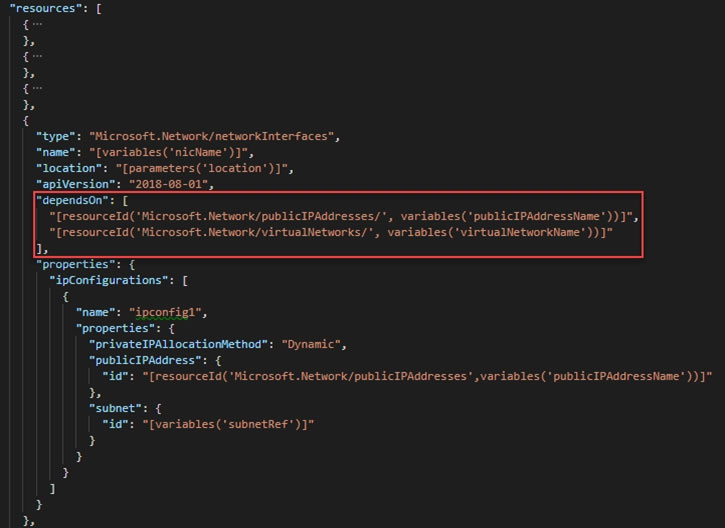
Reference:
https://docs.microsoft.com/en-us/azure/azure-resource-manager/resource-manager-tutorial-create-templates-with-dependent-resources
HOTSPOT -
Your network contains an Active Directory domain named adatum.com and an Azure Active Directory (Azure AD) tenant named adatum.onmicrosoft.com.
Adatum.com contains the user accounts in the following table.

Adatum.onmicrosoft.com contains the user accounts in the following table.
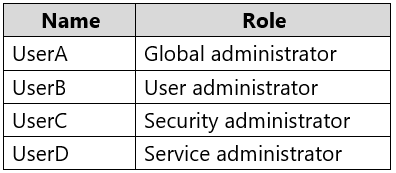
You need to implement Azure AD Connect. The solution must follow the principle of least privilege.
Which user accounts should you use in Adatum.com and Adatum.onmicrosoft.com to implement Azure AD Connect? To answer, select the appropriate options in the answer area.
NOTE: Each correct selection is worth one point.
Hot Area:
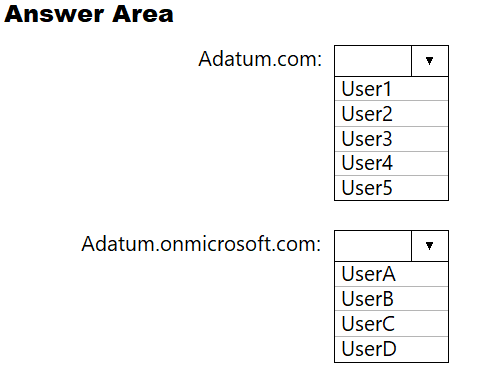
Answer :
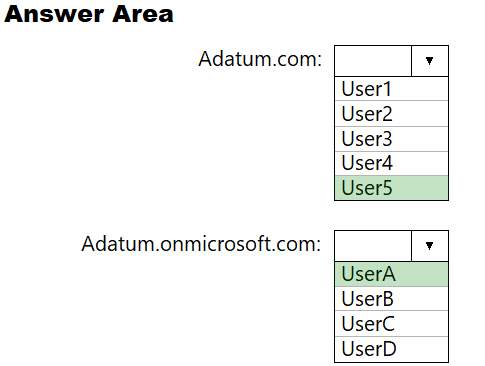
Explanation:
Box 1: User5 -
In Express settings, the installation wizard asks for the following:
AD DS Enterprise Administrator credentials
Azure AD Global Administrator credentials
The AD DS Enterprise Admin account is used to configure your on-premises Active Directory. These credentials are only used during the installation and are not used after the installation has completed. The Enterprise Admin, not the Domain Admin should make sure the permissions in Active Directory can be set in all domains.
Box 2: UserA -
Azure AD Global Admin credentials are only used during the installation and are not used after the installation has completed. It is used to create the Azure AD
Connector account used for synchronizing changes to Azure AD. The account also enables sync as a feature in Azure AD.
Reference:
https://docs.microsoft.com/en-us/azure/active-directory/connect/active-directory-aadconnect-accounts-permissions
You have an Azure subscription that contains 100 virtual machines.
You have a set of Pester tests in PowerShell that validate the virtual machine environment.
You need to run the tests whenever there is an operating system update on the virtual machines. The solution must minimize implementation time and recurring costs.
Which three resources should you use to implement the tests? Each correct answer presents part of the solution.
NOTE: Each correct selection is worth one point.
- A. Azure Automation runbook
- B. an alert rule
- C. an Azure Monitor query
- D. a virtual machine that has network access to the 100 virtual machines
- E. an alert action group
Answer : ABE
Explanation:
AE: You can call Azure Automation runbooks by using action groups or by using classic alerts to automate tasks based on alerts.
B: Alerts are one of the key features of Azure Monitor. They allow us to alert on actions within an Azure subscription
Reference:
https://docs.microsoft.com/en-us/azure/automation/automation-create-alert-triggered-runbook https://techsnips.io/snips/how-to-create-and-test-azure-monitor-alerts/?page=13

